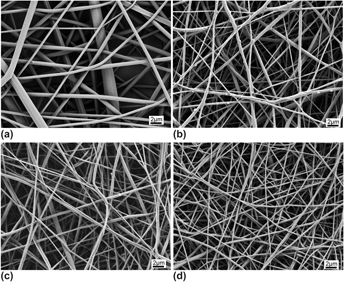Crossref Citations
This article has been cited by the following publications. This list is generated based on data provided by
Crossref.
Küng, Florian
Schubert, Dirk W.
Stafiej, Piotr
Kruse, Friedrich E.
and
Fuchsluger, Thomas A.
2016.
A novel suture retention test for scaffold strength characterization in ophthalmology.
Materials Science and Engineering: C,
Vol. 69,
Issue. ,
p.
941.
Li, Wei
Li, Tingting
Liu, Ce
An, Libao
Li, Yuqing
Zhang, Weiwei
Liu, Lu
and
Zhang, Zhiming
2016.
Greatly enhanced photocatalytic activity and mechanism of H3PW12O40/polymethylmethacrylate/polycaprolactam sandwich nanofibrous membrane prepared by electrospinning.
Journal of Materials Research,
Vol. 31,
Issue. 19,
p.
3060.
Rao, Chengchen
Gu, Fu
Zhao, Peng
Sharmin, Nusrat
Gu, Haibing
and
Fu, Jianzhong
2017.
Capturing PM2.5 Emissions from 3D Printing via Nanofiber-based Air Filter.
Scientific Reports,
Vol. 7,
Issue. 1,
Obregón, R.
Ramón-Azcón, J.
and
Ahadian, S.
2017.
Nanofiber Composites for Biomedical Applications.
p.
483.
Ahadian, S.
Obregón, R.
Ramón-Azcón, J.
Salazar, G.
and
Ramalingam, M.
2017.
Nanofiber Composites for Biomedical Applications.
p.
507.
Bertram, Ulf
Steiner, Dominik
Poppitz, Benjamin
Dippold, Dirk
Köhn, Katrin
Beier, Justus P.
Detsch, Rainer
Boccaccini, Aldo R.
Schubert, Dirk W.
Horch, Raymund E.
and
Arkudas, Andreas
2017.
Vascular Tissue Engineering: Effects of Integrating Collagen into a PCL Based Nanofiber Material.
BioMed Research International,
Vol. 2017,
Issue. ,
p.
1.
Küng, Florian
Schubert, Dirk W.
Stafiej, Piotr
Kruse, Friedrich E.
and
Fuchsluger, Thomas A.
2017.
Influence of operating parameters on the suture retention test for scaffolds in ophthalmology.
Materials Science and Engineering: C,
Vol. 77,
Issue. ,
p.
212.
Mi, Hao-Yang
Jing, Xin
Yu, Emily
Wang, Xiaofeng
Li, Qian
and
Turng, Lih-Sheng
2018.
Manipulating the structure and mechanical properties of thermoplastic polyurethane/polycaprolactone hybrid small diameter vascular scaffolds fabricated via electrospinning using an assembled rotating collector.
Journal of the Mechanical Behavior of Biomedical Materials,
Vol. 78,
Issue. ,
p.
433.
Esfahani, Hamid
Darvishghanbar, Mahsa
and
Farshid, Behzad
2018.
Enhanced bone regeneration of zirconia-toughened alumina nanocomposites using PA6/HA nanofiber coating via electrospinning.
Journal of Materials Research,
Vol. 33,
Issue. 24,
p.
4287.
Delyanee, Mahsa
Solouk, Atefeh
Akbari, Somaye
and
Seyedjafari, Ehsan
2018.
Modification of electrospun poly(L-lactic acid)/polyethylenimine nanofibrous scaffolds for biomedical application.
International Journal of Polymeric Materials and Polymeric Biomaterials,
Vol. 67,
Issue. 4,
p.
247.
Mi, Hao-Yang
Jing, Xin
Thomsom, James A.
and
Turng, Lih-Sheng
2018.
Promoting endothelial cell affinity and antithrombogenicity of polytetrafluoroethylene (PTFE) by mussel-inspired modification and RGD/heparin grafting.
Journal of Materials Chemistry B,
Vol. 6,
Issue. 21,
p.
3475.
Gordegir, Meleknur
Oz, Sultan
Yezer, Irem
Buhur, Merve
Unal, Betul
and
Demirkol, Dilek Odaci
2019.
Cells-on-nanofibers: Effect of polyethyleneimine on hydrophobicity of poly-Ɛ-caprolacton electrospun nanofibers and immobilization of bacteria.
Enzyme and Microbial Technology,
Vol. 126,
Issue. ,
p.
24.
Razmshoar, Pouyan
Bahrami, S. Hajir
and
Akbari, Somaye
2020.
Functional hydrophilic highly biodegradable PCL nanofibers through direct aminolysis of PAMAM dendrimer.
International Journal of Polymeric Materials and Polymeric Biomaterials,
Vol. 69,
Issue. 16,
p.
1069.
Morales-Gonzalez, Maria
Arévalo-Alquichire, Said
Diaz, Luis E.
Sans, Juan Ángel
Vilariño-Feltrer, Guillermo
Gómez-Tejedor, José A.
and
Valero, Manuel F.
2020.
Hydrolytic stability and biocompatibility on smooth muscle cells of polyethylene glycol–polycaprolactone-based polyurethanes.
Journal of Materials Research,
Vol. 35,
Issue. 23-24,
p.
3276.
Niu, Xiaolian
Wang, Longfei
Xu, Mengjie
Qin, Miao
Zhao, Liqin
Wei, Yan
Hu, Yinchun
Lian, Xiaojie
Liang, Ziwei
Chen, Song
Chen, Weiyi
and
Huang, Di
2021.
Electrospun polyamide-6/chitosan nanofibers reinforced nano-hydroxyapatite/polyamide-6 composite bilayered membranes for guided bone regeneration.
Carbohydrate Polymers,
Vol. 260,
Issue. ,
p.
117769.
Delyanee, Mahsa
Solouk, Atefeh
Akbari, Somaye
and
Daliri Joupari, Morteza
2021.
Engineered hemostatic bionanocomposite of poly(lactic acid) electrospun mat and amino‐modified halloysite for potential application in wound healing.
Polymers for Advanced Technologies,
Vol. 32,
Issue. 10,
p.
3934.
Delyanee, Mahsa
Akbari, Somaye
and
Solouk, Atefeh
2021.
Amine-terminated dendritic polymers as promising nanoplatform for diagnostic and therapeutic agents’ modification: A review.
European Journal of Medicinal Chemistry,
Vol. 221,
Issue. ,
p.
113572.
Yu, Chenglong
Yang, Huaguang
Wang, Lu
Thomson, James A.
Turng, Lih-Sheng
and
Guan, Guoping
2021.
Surface modification of polytetrafluoroethylene (PTFE) with a heparin-immobilized extracellular matrix (ECM) coating for small-diameter vascular grafts applications.
Materials Science and Engineering: C,
Vol. 128,
Issue. ,
p.
112301.
Delyanee, Mahsa
Solouk, Atefeh
Akbari, Somaye
and
Daliri, Morteza
2022.
Hemostatic Electrospun Nanocomposite Containing Poly(lactic acid)/Halloysite Nanotube Functionalized by Poly(amidoamine) Dendrimer for Wound Healing Application: In Vitro and In Vivo Assays.
Macromolecular Bioscience,
Vol. 22,
Issue. 1,
Tu, Sung-Lin
Chen, Chih-Kuang
Shi, Shih-Chen
and
Yang, Jason Hsiao Chun
2022.
Plasma-Induced Graft Polymerization of Polyethylenimine onto Chitosan/Polycaprolactone Composite Membrane for Heavy Metal Pollutants Treatment in Industrial Wastewater.
Coatings,
Vol. 12,
Issue. 12,
p.
1966.
